Great science fiction takes real science concepts and stretches them past their limits. Time and time again, we’ve seen that scenario reversed, where real life scientific pursuits are first conjured up in the minds of sci-fi writers (cell phones, anyone?). Trek tech inspiring real products is nothing new. This month, designs for a faster-than-light ship, a handheld tricorder-like device (yes, another one), and even talk of creating real food replicators has all popped up in the news. Plus, Trek is making its presence known in low Earth orbit thanks to a Trekkie astronaut. Hit the jump for more.
Trek-inspired FTL Ship: The IXS Enterprise
There’s no question that the design for this faster-than-light capable ship, dubbed the IXS Enterprise by its creator, is inspired by Star Trek. NASA engineer and physicist Harold White has been hinting for years at his work on a “groundbreaking” idea that could allow us to achieve travel faster than the speed of light. Now, he’s teamed up with designer Mark Rademaker to create this CGI mockup of what such a ship could look like.
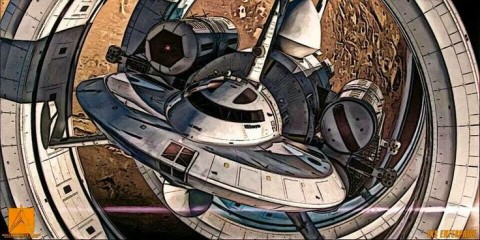
The technology used to reach FTL speeds hinges on the same idea that powers the USS Enterprise in Star Trek, and in doing so, it still obeys Einstein’s galactic speed limit. Our modern understanding of physics says that nothing with mass can travel faster than the speed of light, but it doesn’t say that space itself can’t travel as fast as it pleases (in fact, it is thought that the universe is expanding faster than the speed of light). So, a warp drive like that planned for the imaginary IXS Enterprise would warp space around the ship instead of brute force propelling the ship from one place to another. This means that the travel distance (and therefore necessary speed) is effectively reduced from the perspective of the ship.
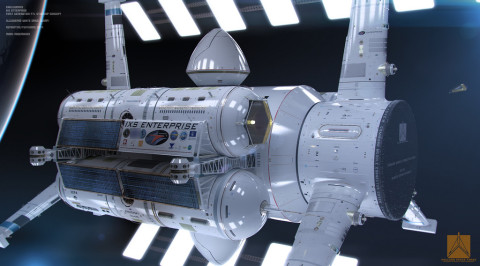
But, don’t get your hopes too high on this one, folks. While the design is gorgeous and we wish we could ride to Alpha Centauri tomorrow, the IXS Enterprise’s main goal is to encourage kids to take on STEM (Science, Technology, Engineering, and Math) careers.
“We wanted to have a decent image of a theory conforming Warp ship to motivate young people to pursue a STEM career,” Rademaker said in an e-mail interview to the Washington Post. “It does have some Sci-Fi features that might never transfer to a possible final design, unless we really want to.”
At this point, the warp ship is no more real than Gene Roddenberry’s NCC-1701. And, while that might not make the splashiest headline, this humble writer who was inspired into a science career in part due to Trek would like to think that this is a far nobler goal.
Check out Mark Rademaker’s flickr page for some high resolution images of this truly sexy ship.
White explains his warp ship in this one hour lecture
Another Real Life Tricorder (But, this time you can buy one!)
You’ve read this headline before, “Company Develops Real Life Tricorder!“. And, yes, this is another one of those stories – with an important caveat. You can actually buy this one! Consumer Physics, Inc. has created a pocket-sized molecular scanner and symbiotic smart phone app for actual consumer use. The SCiO, available for pre-order at a measly $299, is a handheld spectrometer scanner that can give you chemical information about your food, your clothes, just about anything around you. The device uses existing technology – spectrometers of many different flavors are laboratory work horses in many fields, but typically run in the millions of dollars and require a specialized technician to operate. What Consumer Physics has achieved is a scaling back of this technology to the point where the device itself is affordable to the average consumer and the information it displays can be understood by someone without a PhD. Of course, your average $5 million instrument over at your local university likely wins out for accuracy and precision, but if you’re simply curious about the calories in your food, you probably don’t need the kind of data that would pass peer-reviewed scientific muster.
The SCiO has already been successfully funded on Kickstarter, blowing past its goal of $200,000 at an astounding $2,762,571. Check out their video below.
Nestlé wants to make Star Trek replicators
Nestlé, the largest food and beverage company in the world, have decided to tackle vitamin and mineral deficiency by dreaming up Star Trek-style replicators that would scan a user, determine the nutrients that person needs most, and whip up a dish to serve their dietary needs best.
Their research division, the Nestlé Institute of Health Sciences (NIHS), has created a program (ironically) called “Iron Man” in the hopes of developing this technology. The replicator itself is at least several decades away, NIHS admits, but the field of nutrigenomics, the study of how food affects the expression of genes, could be the first step toward tailoring diets to individuals.
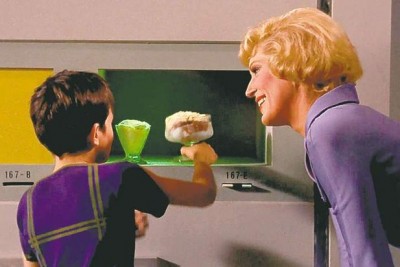
Personally, I’d use a replicator to make endless appletinis and ice cream sundaes, so the nutrition part of this story may be lost on me…
Things get geeky in low Earth orbit thanks to a Trekkie astronaut
Steven Swanson, current commander of the International Space Station, is bringing geeky back (can we make this phrase a thing?). Trekkie, Browncoat, and all around sci-fi fan, Swanson has been strutting his favorite fandoms in the form of T-shirts and DVDs.
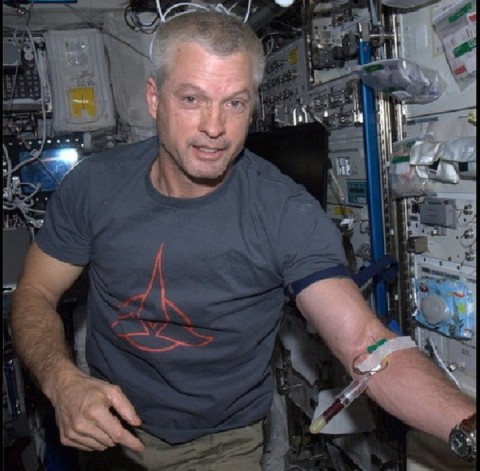
Swanson instagram’d this photo with the caption, “Blood, sweat, but hopefully no tears.” – Swanny #nasa #iss #exp39 #international #space #station #blood #sweat #tears #medical
Swanson even had a Trekkie design for the Expedition 40 mission patch! As GEEK Magazine explains:
Collaborating with his daughter, computer science major and one time graphic designer Caroline, Swanson designed a badge that to him represented both the impact that science fiction has had on actual science as well as space exploration. The pair zeroed in on a symbol of the Klingon race. For those not familiar with Star Trek, the Klingons are arguably the most badass of the races we meet in the Trek universe.
Unfortunately, NASA ultimately vetoed the design fearing it was too much of an advertisement for Star Trek (and, I suppose, government organizations need to tread lightly in this kind of legal territory).
“He mentioned Star Trek and the influence that television and movies about space travel have had on him and the youth of American, or the world even,” Swanson’s wife Mary told collectSpace,” and how [the patch] was paying homage to how that has stirred the imaginations of thousands of people and made them want to maybe become astronauts, or at least work in the space program.”

Join Kayla’s Trek to Vandenberg Air Force Base for OCO-2 Satellite Launch
Last but not least I wanted to bring your attention to my upcoming trip down to Vandenberg Air Force Base in Lompoc, CA. I feel so honored to have been invited to attend a @NASASocial event to tour the base, meet the scientists behind the Orbiting Carbon Observatory 2 (OCO-2) spacecraft, and even watch the newest Earth-observing satellite blast off during a 2:56am launch aboard a Delta II rocket.
This awesome video explains just what OCO-2 will be doing up there
Of course, my trip would be lonely without you TrekMoviers, so I’m taking you along with me (like it or not). You can follow my adventure on my twitter account, @kaylai (and probably some tweets on the official @TrekMovie account, too). Plus, I’ll write up a post detailing my trip when I return. I’m hitting the road to Lompoc in a few short hours, so tweet at me or leave a comment here to tell me what you’d like to know about the mission, the scientists, the base, or anything you’re curious about! You can also follow the mission at @IamOCO2, and watch for hashtags #OCO2, #EarthRightNow, and #NASASocial.

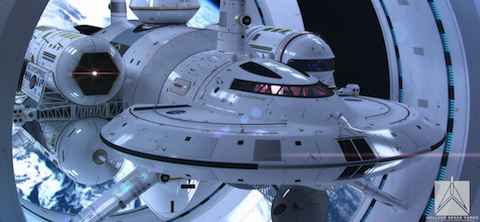
Love the design of White and Rademaker’s ship. If only something like this could be realized in my lifetime!! And how great is it to have Trekkies in space?!?
Another great article Dr. Iacovino! FTL travel, food replicators, tricorders and astronaut Trekkies! Wow Kayla! You and the rest of the good Trekmovie folk are are making it hard to stay away from this site! Wish I could come to Vegas and see you. Maybe one day. But thanks for getting this site back up to warp speed! I am officially impressed!
I have written science speculation and futurist articles and books for over 30 years. Yes, TOS was my inspiration for my profession. When I used to write articles about science innovations, I would often point out that Star Trek had something similar which had now just become reality.
However these days, for whatever wonderful, crazy reason, I am finding that the inventors, scientists, innovators, mention it themselves quite often. I think this is because we have caught up, so to speak, so now the projects are things like designing how a craft would go to warp and what kind of craft it would have to be that could stand warp. How does one of the guys working on this project describe what he is doing without saying “Star Trek”?? He cannot–.
There is even small progress toward the molecular transporter – a Japanese team transported/teleported tiny particles recently. They did not replicate them but actually transported them.
So it’s not just the guy who invented the cell phone who did so because of Trek’s communicator (he willingly says this is the gospel truth), it is the quantum physicists and NASA engineers working on the BIG STUFF like the ship and the transporter – even if in infancy stages.
I am no spring chicken and I have to say, sometimes I wonder if the popcorn movie crowd has any idea what GR— oh well.
Someone on this site once said, “There are no new science innovations, it has pretty much been all found out,” and so we are to look to personal romances in the Trek universe. How wrong is her first statement! Science is exploding as never before. We have gone where we never thought we would have gone 5 years ago, even!
And as for the 2nd statement, Trek is science fiction. It is a genre which has a paradigm like all genres. It’s not soap opera.
Great article, trekmovie!
Fun designs!
A warp drive ship in our lifetime?
NOW I’m excited!
Physics, shmisics…
I want a warp ship!!! I wannit!!!
Warp drive is too slow.
We need to be thinking ahead to ludicrous drive.
6. Cygnus-X1 –
“Warp drive is too slow.
We need to be thinking ahead to ludicrous drive.”
L! O! L!
They’ve gone to plaid!
Wow, I love the CGI mockup!
The most ironious irony of them all: Nestlé have an institute of health science named after them.
The ship is lovely, though. I’d totally watch a TV show based on that concept… a real warp ship visiting real exoplanets.
OMG. The vessel (I have seen it before) looks amazing. I thought they were talking of a new sci-fi show when I saw it. This is FTL of today.
The commander of the ISS would be awesome to geek out with. Wonder if he is a fan of Doctor Who.
I am not sure if food replicators today can handle the intricacies of taste and smell enough to fool us into thinking it is not artificial, but it would be a step closer to eradicating need and want.
@11 (Richard Blanchard): Not to mention the fact that you would need a way to maximize the efficiency of your supplies for the long term.
This thing could also turn into the ‘Event Horizon’. It’s all fun and games until someone gets hurt. :-)
I wonder if Kayla Lacovino can confirm or otherwise, but I believe that one of the biggest reasons of all why human beings have not ventured further than the moon is because of deadly cosmic rays that are everywhere. No protective shielding has been discovered that would allow safe passage for any sentient life on earth beyond the earth and moon. The earth, and the moon, by virtue of being part of earth’s gravitational field, has a special shielding – a kind of electro-magnetic, which protects it from most of the heavy bombardment of cosmic rays that both the earth and moon would otherwise experience. So until something is discovered to protect any space faring vessel and its human and/or other occupants from these deadly rays, no space travel is possible for man, no matter how good the artificial gravity plating, the warp drive or other fuel providing much greater speeds than we presently have, might be etc.
Some cosmic rays do get through and it is thought that they may be responsible for some of the random occurrences where a child is born with genetic mutation or other, some serious and others not so much. In the early stages of pregnancy, if the mother is bombarded with a stray cosmic ray, then the abnormality will occur in her offspring. It is thought to adversely affect DNA/genetic material at low levels and none is more vulnerable than an embryo or fetus.
Hi Keachick,
Yes, indeed, cosmic radiation is a very legitimate concern, from what I understand. The cost penalty of a physical shield could be prohibitive if we use currently available means of spacecraft propulsion.
However, there are ways and means around the problem. A quick Google search produced the following article, which may be of interest to you.
http://physicsworld.com/cws/article/news/2008/nov/06/magnetic-shield-could-protect-spacecraft
As for the larger issue, a sufficiently advanced propulsion system could make the cost penalty of a shielding system, physical or otherwise, much less prohibitive.
Current and relatively conventional research efforts (i.e., not warp-drive or FTL) have yielded promising avenues toward nonchemical means of propulsion. Former NASA astronaut Franklin Chang-Diaz heads up a company that is developing an ion drive of sufficient power that it might be used for human spaceflight in the future.
The Deep Space One NASA probe also has effectively shown that ion propulsion has real-world applications.
There are many advances ahead that will help us bridge the gap that separates us from the stars.
The recent discovery of a massive, Earth-like planet “merely” 16 light-years away — the most Earth-like planet yet discovered — may serve as an incentive for humanity to apply its ingenuity toward spaceflight over the course of the next hundred years.
I Googled the latest on Dr. Chang-Diaz’s work and found the following link from his company.
Here’s a bit of light reading in the form of a recent paper presented at an academic symposium held at George Washington University, in which the results of a study concerning estimates for the mass efficiency of the VASIMR engine currently under development by Chang-Diaz’s Ad Astra Rocket Company were presented. In brief, the paper appears to conclude that the efficiency of the engine increases asymptotically in the domain of power generation between 50 kilowatts and 250 kilowatts. (See Figure 3, system alpha (kg/kW).)
The paper was co-authored by various scientists and other experts including a Professor of Physics from the University of Houston and an Assistant Professor of Aerospace Engineering from the University of Michigan, Ann Arbor.
Sorry, forgot the link:
http://www.adastrarocket.com/IEPC13-149_JPSquire_submit.pdf
We’re going to Mars in the 2030s http://arstechnica.com/science/2012/12/nasa-will-send-second-mars-rover-in-2020-send-humans-in-2030s/ – so the radiation barrier is in the process of being diminished/eliminated.
Incidentally, a private group is sending a rover to Mars in 2018 ahead of NASA’s next attempt. It is called The Boldly Go Foundation. Now, I wonder where that name came from?!
http://www.dailymail.co.uk/sciencetech/article-2668494/The-private-mission-Mars-set-beat-Nasa-bring-dust-red-planets-atmosphere-Earth-2018.html
I feel that Star Trek has a role in our ongoing evolution, not only physical/scientific, but mental, even spiritual, if you will (not “spiritual” in the religious sense). Evolution is a force which exists in our collective consciousness; we usually do not think of it or feel it, but it is there – it has to be or we would die as a species. We need that collective message, that collective energy.
For whatever crazy reason, GR tapped into that collective human river. And to be honest, this is why I feel so strongly that Trek can’t be turned into a popcorn movie fantasy fest.
The reason TOS (mostly) seems to have seen the future regarding inventions and scientific innovations and progress is that this is the physical/scientific aspect of the human evolution GR saw.
TOS’ message is the mental/spiritual aspect of our collective evolution. They are not perfect, they are not a holy book of any kind, but they offer us a glimpse into our future. It DOES exist and our collective evolution is possible.
There are always possibilities and we can choose the dynamic, healthy, thrilling ones: To Boldly Go!
None of the links posted above appear to have said anything about a solution to the very real problem of any astronaut being subjected to cosmic rays once they leave the protective barrier that surrounds the earth and moon. In fact, the first link tells of work being done to protect from the solar wind but, at the end of the article, there is this –
“She does point out, however, that even if the technology works it will not provide complete protection. For one thing, it could not shield astronauts against very high energy intergalactic cosmic rays.”
The other links talk about the millions of dollars that need to be spent to get to Mars and of a vessel that will be able to get samples etc, travel at higher speeds, man going to Mars by 2030 but no mention of what is being done to counteract the effects of the cosmic rays which are everywhere. If there is a solution being worked on, these articles say nothing about it.
#20. Keachick (Rose) – July 2, 2014
Well I had to dig deep for your answer. Harry’s probably going to have field day with this. People are going to joke that we generate enough of it in these parts for a millennium of Mars missions.
“It’s a little queasy sounding, but there’s no place for that material to go, and it makes great radiation shielding.” –Taber MacCallum
Here’s your answer from last year’s NEW SCIENTIST:
http://www.newscientist.com/article/dn23230-mars-trip-to-use-astronaut-poo-as-radiation-shield.html
I’d probably like to combine it with a Magnetic Bubble Shield:
https://www.sciencenews.org/article/magnetic-bubbles-could-shield-astronauts-radiation
Thou shalt love thy poo!
Having food etc around the walls of the ship reminds of the Enterprise episode – Unexpected, where the Xyrillians decorate their walls with food which grows from out of the walls of the ship and the crew can feast pretty much whenever they want. It looked very attractive. This is also the episode where Trip Tucker gets pregnant!…:)
So it seems those Xyrillians might be on to something here. No mention of feces though…:)
@21 Disinvited
Wow! Instead of saying “the sh*t is hitting the fan!”, we can now proclaim “the sh*t is providing a shield!”
When hearing this fact, I could say “no sh*t”, but I’d be wrong!
I had to check back to see if the link was not some kind of April Fools’ joke. It is not.
My husband said that it could work, does make sense…who knew?
As I say, Thou shalt love thy poo!
Thus the old expression, “throw enough sh*t up on the wall, some of it will stick!”
(and save your life by doing so)
“A poop question?”
Commander Charles “Trip” Tucker III
ALL HANDS ON THE POOP DECK!
Scotty: Shields at 50 percent.
Kirk: Everyone to the latrines! And don’t forget to flush!
I hope it has some kind of shuttle bay too.
The twin doors on the front look reminissant of the Discovery’s from 2001/2010 fame.